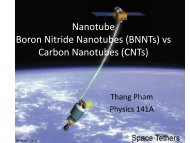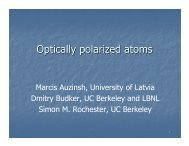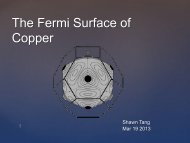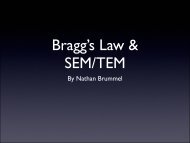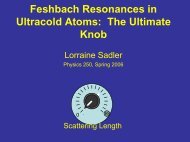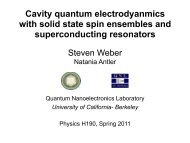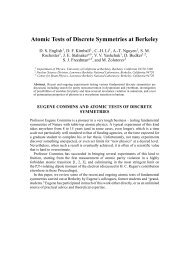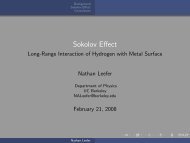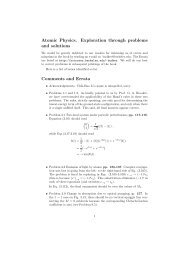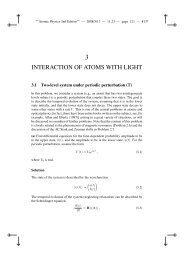Resonant nonlinear magneto-optical effects in atomsâ - The Budker ...
Resonant nonlinear magneto-optical effects in atomsâ - The Budker ...
Resonant nonlinear magneto-optical effects in atomsâ - The Budker ...
Create successful ePaper yourself
Turn your PDF publications into a flip-book with our unique Google optimized e-Paper software.
15<br />
effect. 15 Many experiments were performed us<strong>in</strong>g this<br />
idea (reivewed by Happer, 1971). For <strong>optical</strong> pump<strong>in</strong>g<br />
studies, off-resonance detection of dispersive properties<br />
has the advantage over absorption monitor<strong>in</strong>g that<br />
the probe beam <strong>in</strong>teracts only weakly with the pumped<br />
atoms. Thus high probe-beam <strong>in</strong>tensities can be used,<br />
enhanc<strong>in</strong>g the signal-to-noise ratio of the detection, without<br />
loss of sensitivity due to power broaden<strong>in</strong>g. On the<br />
other hand, a probe beam detuned from exact resonance<br />
could <strong>in</strong>duce light shifts 16 of the atomic energy levels,<br />
which may not be acceptable <strong>in</strong> high-precision work.<br />
Because the <strong>optical</strong> properties of the atomic vapor are<br />
altered by the pump beam, and these changes are detected<br />
by <strong>optical</strong> means, <strong>optical</strong> pump<strong>in</strong>g is classified as<br />
a <strong>nonl<strong>in</strong>ear</strong> processes. However, it should be realized<br />
that <strong>in</strong> most of the pre-laser cases, the effect was due<br />
to the cumulative action of several <strong>optical</strong> pump<strong>in</strong>g cycles,<br />
i.e., sequences of absorption and spontaneous emission,<br />
occurr<strong>in</strong>g on a time scale shorter than the lower<br />
state relaxation time, but longer than the upper-state<br />
lifetime. Thus no appreciable upper-state population was<br />
produced.<br />
Nonl<strong>in</strong>ear <strong>effects</strong> related to upper state saturation can<br />
arise even with lamps as light sources, however, provided<br />
that the light <strong>in</strong>tensity is strong enough. An example<br />
of this can be found <strong>in</strong> the work of Schmieder et al.<br />
(1970) who <strong>in</strong>vestigated level-cross<strong>in</strong>g signals <strong>in</strong> the fluorescence<br />
of Rb and Cs vapors. At high light <strong>in</strong>tensities,<br />
narrow features appeared <strong>in</strong> the magnetic field dependence<br />
near B = 0. <strong>The</strong>y were ascribed to the appearance<br />
of the ground-state Hanle signal <strong>in</strong> the excited-state fluorescence<br />
due to <strong>nonl<strong>in</strong>ear</strong> coupl<strong>in</strong>g of the ground- and<br />
excited-state coherences. As with the Hanle experiment<br />
(Sec. II.D.1), the width of the resonance depended on<br />
the relaxation time of the atomic state; however, <strong>in</strong> contrast<br />
to the orig<strong>in</strong>al Hanle effect, here it was the groundstate<br />
relaxation, rather than the upper-state relaxation,<br />
which was relevant. Very narrow widths (on the order<br />
of 1 µG) were seen by Dupont-Roc et al. (1969), who<br />
observed the ground-state Hanle effect <strong>in</strong> transmission.<br />
In this work, rubidium atoms conta<strong>in</strong>ed <strong>in</strong> a paraff<strong>in</strong>coated<br />
vapor cell (see Sec. VIII.E) were <strong>optical</strong>ly pumped<br />
by a circularly polarized beam from a Rb lamp, and<br />
15 Strictly speak<strong>in</strong>g, the paramagnetic Faraday effect is not a<br />
<strong>magneto</strong>-<strong>optical</strong> effect, s<strong>in</strong>ce it occurs even when there is no magnetic<br />
field present. Still, it affects atomic dispersion, and so can<br />
play a role <strong>in</strong> <strong>magneto</strong>-<strong>optical</strong> <strong>effects</strong>.<br />
16 <strong>The</strong> quantum theory of light shifts <strong>in</strong> the context of <strong>optical</strong><br />
pump<strong>in</strong>g was developed by Barrat and Cohen-Tannoudji (1961)<br />
(also see discussion by Cohen-Tannoudji, 1968). A simple classical<br />
derivation by Pancharatnam (1966) <strong>in</strong>dicated a relation to<br />
atomic dispersion by show<strong>in</strong>g that the light shift is given by a<br />
convolution of the spectral profile of the light field with the real<br />
part of the atomic susceptibility (refractive <strong>in</strong>dex). S<strong>in</strong>ce the real<br />
part of the refractive <strong>in</strong>dex is an anti-symmetric function of the<br />
light detun<strong>in</strong>g from atomic resonance, the light shift vanishes for<br />
resonant light beams.<br />
thus acquired macroscopic orientation (magnetization) <strong>in</strong><br />
their ground state. In the transverse-magnetic-field dependence<br />
of the pump beam transmission, there was a<br />
Lorentzian resonance due to the ground-state Hanle effect.<br />
In order to get a dispersive resonance whose steep<br />
slope near the zero cross<strong>in</strong>g could be used to detect small<br />
magnetic field changes, Dupont-Roc et al. applied modulation<br />
to the magnetic field and performed lock-<strong>in</strong> detection<br />
of the transmitted light <strong>in</strong>tensity at the modulation<br />
frequency. <strong>The</strong> ground-state Hanle effect studied<br />
was applied to ultra-sensitive <strong>magneto</strong>metry by Cohen-<br />
Tannoudji et al. (1969); Dupont-Roc (1970), provid<strong>in</strong>g<br />
sensitivity ∼10 −9 G Hz −1/2 .<br />
Bouchiat and Grossetete (1966) performed experiments<br />
that were an important precursor to later NMOE<br />
work with lasers (particularly, that which utilized separated<br />
pump and probe light fields). <strong>The</strong>y illum<strong>in</strong>ated an<br />
alkali vapor cell subject to a magnetic field with pump<br />
and probe lamp light sources <strong>in</strong> order to carry out detailed<br />
studies of sp<strong>in</strong>-relaxation and sp<strong>in</strong>-exchange processes.<br />
An <strong>in</strong>terest<strong>in</strong>g feature of this setup is that the<br />
pump and probe light fields could be resonant with different<br />
transitions of the same atom, or even with transitions<br />
<strong>in</strong> different isotopes or species. In the latter cases, atomic<br />
polarization <strong>in</strong>duced by the pump light <strong>in</strong> one isotope or<br />
species is transferred to the other via sp<strong>in</strong>-exchange collisions.<br />
B. Nonl<strong>in</strong>ear <strong>magneto</strong>-<strong>optical</strong> <strong>effects</strong> <strong>in</strong> gas lasers<br />
When a magnetic field is applied to a gas laser medium,<br />
several <strong>nonl<strong>in</strong>ear</strong> <strong>magneto</strong>-<strong>optical</strong> <strong>effects</strong> can be observed<br />
by monitor<strong>in</strong>g laser <strong>in</strong>tensity or the fluorescence light<br />
laterally emitted from the laser tube. 17 <strong>The</strong>se <strong>effects</strong><br />
<strong>in</strong>clude <strong>nonl<strong>in</strong>ear</strong> Hanle and level-cross<strong>in</strong>g <strong>effects</strong> (Sec.<br />
II.B) and also a specific coherence effect, known as mode<br />
cross<strong>in</strong>g. Mode cross<strong>in</strong>g occurs when the frequency separation<br />
between two laser modes matches the Zeeman<br />
splitt<strong>in</strong>g of a pair of magnetic sublevels. <strong>The</strong> two sublevels<br />
are then coherently driven by the two laser modes,<br />
result<strong>in</strong>g <strong>in</strong> a resonance feature <strong>in</strong> the magnetic dependence<br />
of the output power (Dumont, 1972; Hermann<br />
et al., 1977; Hermann and Scharmann, 1972; Schlossberg<br />
and Javan, 1966). Mode cross<strong>in</strong>g is an example of a threelevel<br />
coherence resonance, related to various <strong>effects</strong> described<br />
<strong>in</strong> Sec. XIII.A.<br />
Most gas lasers have tubes with Brewster w<strong>in</strong>dows and<br />
so possess high polarization anisotropy. Such lasers are<br />
sensitive to <strong>magneto</strong>-<strong>optical</strong> <strong>effects</strong> s<strong>in</strong>ce the <strong>in</strong>fluence of<br />
17 Such <strong>effects</strong> were extensively studied <strong>in</strong> the early days of<br />
laser physics, both experimentally (Culshaw and Kannelaud,<br />
1964a,b,c; Dumont and Durand, 1964; Fork et al., 1964; Krupennikova<br />
and Chaika, 1966; Schlossberg and Javan, 1966; Toml<strong>in</strong>son<br />
and Fork, 1967) and theoretically (Dyakonov and Perel,<br />
1966; van Haer<strong>in</strong>gen, 1967; Sargent et al., 1967).





